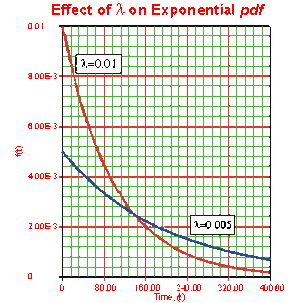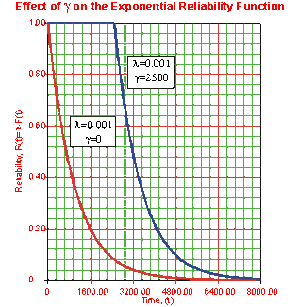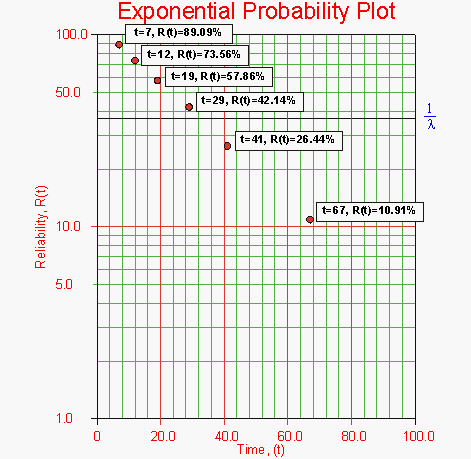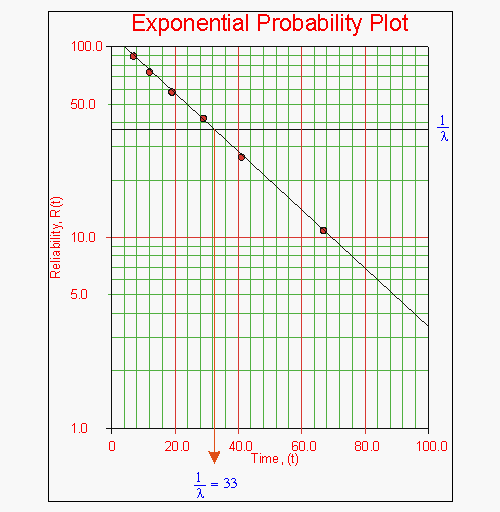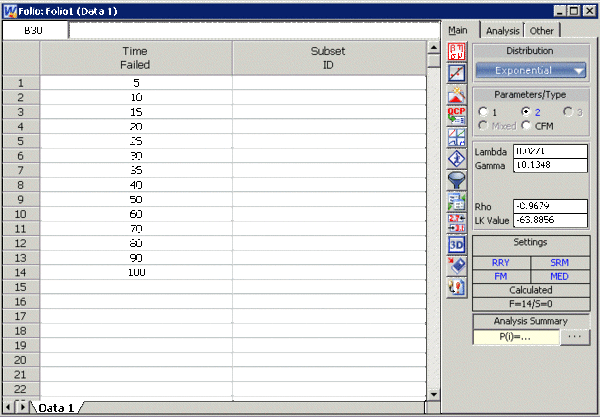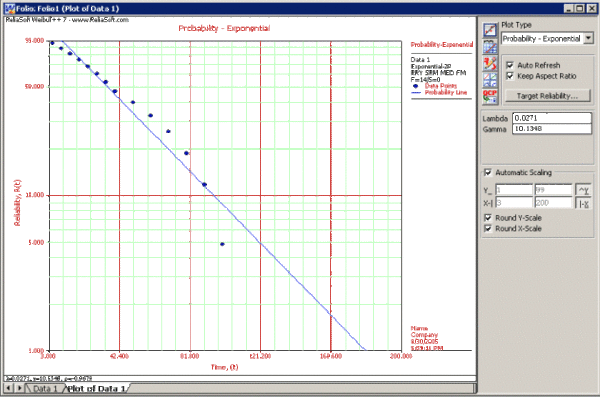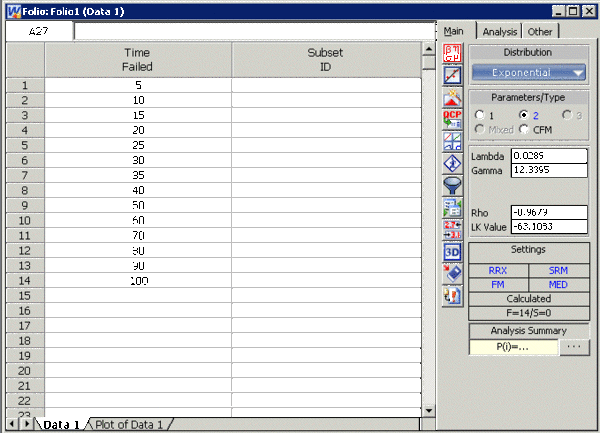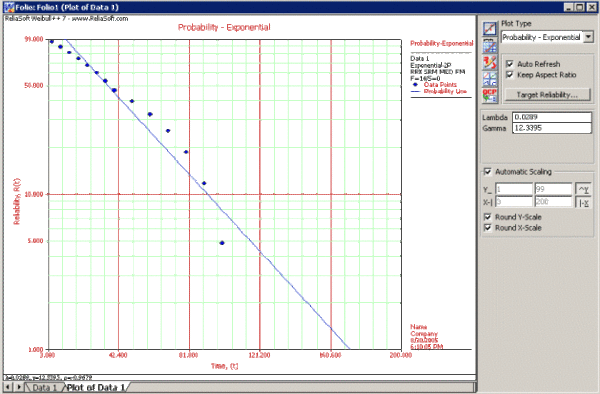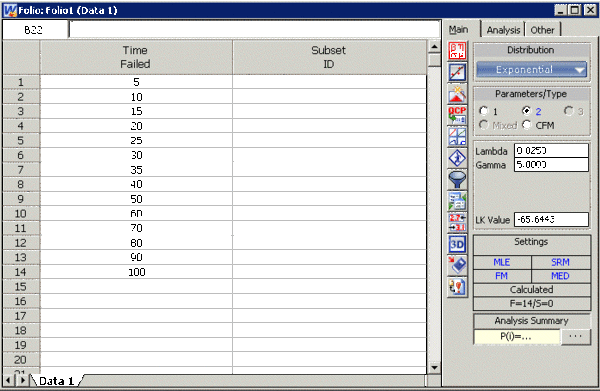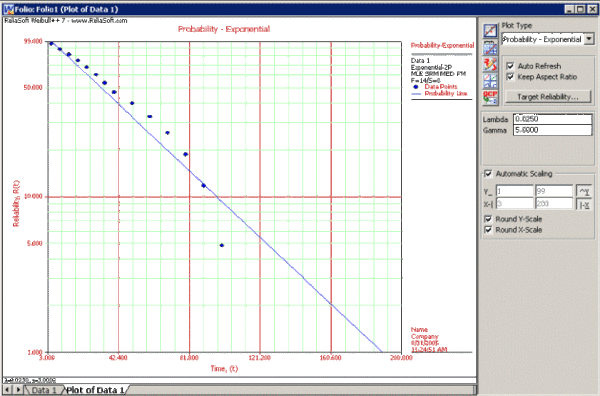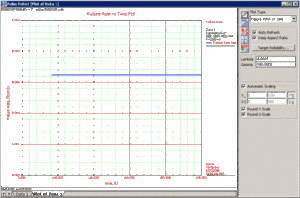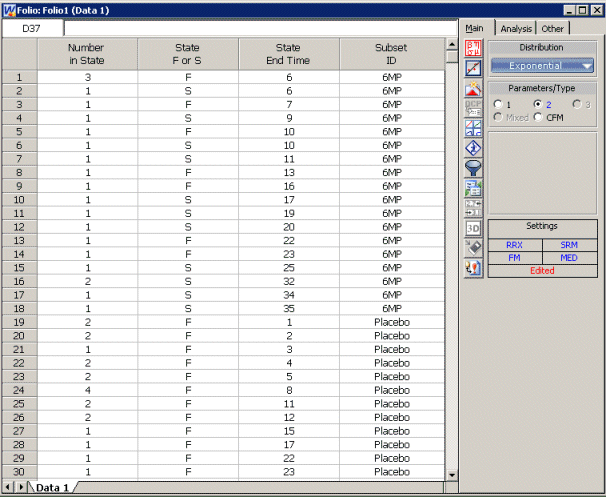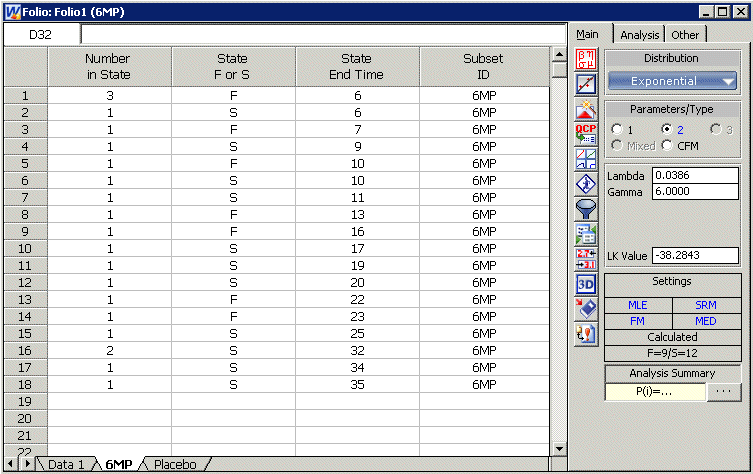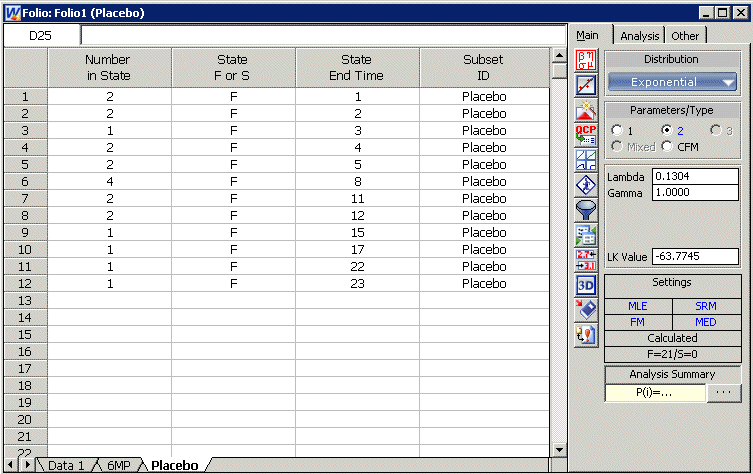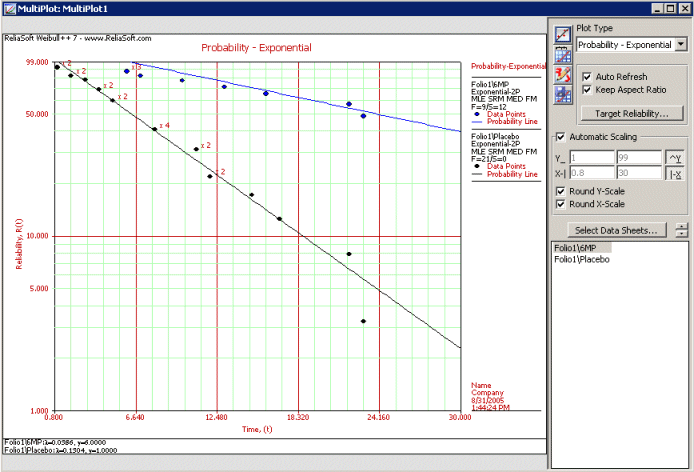The Exponential Distribution
The Exponential Distribution
The exponential distribution is a commonly used distribution in reliability engineering. Mathematically, it is a fairly simple distribution, which many times leads to its use in inappropriate situations. It is, in fact, a special case of the Weibull distribution where
Exponential Probability Density Function
The Two-Parameter Exponential Distribution
The two-parameter exponential
where
- The location parameter,
- The scale parameter is
- The exponential
- The distribution starts at
- As
The One-Parameter Exponential Distribution
The one-parameter exponential
where:
This distribution requires the knowledge of only one parameter,
- The location parameter,
- The scale parameter is
- As
- This distribution has no shape parameter as it has only one shape, i.e. the exponential, and the only parameter it has is the failure rate,
- The distribution starts at
- As
- The
Exponential Statistical Properties
The Mean or MTTF
The mean,
Note that when
The Median
The median,
The Mode
The mode,
The Standard Deviation
The standard deviation,
The Exponential Reliability Function
The equation for the two-parameter exponential cumulative density function, or
Recalling that the reliability function of a distribution is simply one minus the
One-Parameter Exponential Reliability Function
The one-parameter exponential reliability function is given by:
The Exponential Conditional Reliability
The exponential conditional reliability equation gives the reliability for a mission of
which says that the reliability for a mission of
The Exponential Reliable Life
The reliable life, or the mission duration for a desired reliability goal,
or:
The Exponential Failure Rate Function
The exponential failure rate function is:
Once again, note that the constant failure rate is a characteristic of the exponential distribution, and special cases of other distributions only. Most other distributions have failure rates that are functions of time.
Characteristics of the Exponential Distribution
As mentioned before, the primary trait of the exponential distribution is that it is used for modeling the behavior of items with a constant failure rate. It has a fairly simple mathematical form, which makes it fairly easy to manipulate. Unfortunately, this fact also leads to the use of this model in situations where it is not appropriate. For example, it would not be appropriate to use the exponential distribution to model the reliability of an automobile. The constant failure rate of the exponential distribution would require the assumption that the automobile would be just as likely to experience a breakdown during the first mile as it would during the one-hundred-thousandth mile. Clearly, this is not a valid assumption. However, some inexperienced practitioners of reliability engineering and life data analysis will overlook this fact, lured by the siren-call of the exponential distribution's relatively simple mathematical models.
The Effect of
- The exponential
- The exponential
- The value of the
- The location parameter,
- The scale parameter is
- As
The Effect of
- The one-parameter exponential reliability function starts at the value of 100% at
- The two-parameter exponential reliability function remains at the value of 100% for
- As
- The reliability for a mission duration of
Estimation of the Exponential Parameters
Probability Plotting
Estimation of the parameters for the exponential distribution via probability plotting is very similar to the process used when dealing with the Weibull distribution. Recall, however, that the appearance of the probability plotting paper and the methods by which the parameters are estimated vary from distribution to distribution, so there will be some noticeable differences. In fact, due to the nature of the exponential
This is illustrated in the process of linearizing the
Taking the natural logarithm of both sides of Eqn. (Fe) yields:
or:
Now, let:
and:
which results in the linear equation of:
Note that with the exponential probability plotting paper, the y-axis scale is logarithmic and the x-axis scale is linear. This means that the zero value is present only on the x-axis. For
Example 1
Six units are put on a life test and tested to failure. The failure times are 7, 12, 19, 29, 41, and 67 hours. Estimate the failure rate parameter for a one-parameter exponential distribution using the probability plotting method.
Solution to Example 1
In order to plot the points for the probability plot, the appropriate reliability estimate values must be obtained. These will be equivalent to
Next, these points are plotted on exponential probability plotting paper. A sample of this type of plotting paper is shown next, with the sample points in place. Notice how these points describe a line with a negative slope.
Once the points are plotted, draw the best possible straight line through these points. The time value at which this line intersects with a horizontal line drawn at the 36.8% reliability mark is the mean life, and the reciprocal of this is the failure rate
These steps are shown graphically in the next pages.
As can be seen in the plot below, the best-fit line through the data points crosses the
Since
Rank Regression on Y
Performing a rank regression on Y requires that a straight line be fitted to the set of available data points such that the sum of the squares of the vertical deviations from the points to the line is minimized. The least squares parameter estimation method (regression analysis) was discussed in Chapter 3, and the following equations for rank regression on Y (RRY) were derived:
and:
In our case, the equations for
and:
and the
The Correlation Coefficient
The estimator of
Example 2
Fourteen units were being reliability tested and the following life test data were obtained (Table 7.1):
| Data point index | Time-to-failure |
| 1 | 5 |
| 2 | 10 |
| 3 | 15 |
| 4 | 20 |
| 5 | 25 |
| 6 | 30 |
| 7 | 35 |
| 8 | 40 |
| 9 | 50 |
| 10 | 60 |
| 11 | 70 |
| 12 | 80 |
| 13 | 90 |
| 14 | 100 |
Assuming that the data follow a two-parameter exponential distribution, estimate the parameters and determine the correlation coefficient,
Solution to Example 2
Construct Table 7.2, as shown next.
The median rank values (
or:
and:
or:
Therefore, from Eqn. (be):
and from Eqn. (ae):
or:
Then:
The correlation coefficient can be estimated using Eqn. (RHOe):
This example can be repeated using Weibull++, choosing two-parameter exponential and rank regression on Y (RRY), as shown in the figure on the following page.
The estimated parameters and the correlation coefficient using Weibull++ were found to be:
The probability plot can be obtained simply by clicking the Plot icon.
Rank Regression on X
Similar to rank regression on Y, performing a rank regression on X requires that a straight line be fitted to a set of data points such that the sum of the squares of the horizontal deviations from the points to the line is minimized.
Again the first task is to bring our exponential
The corresponding equations for
and:
where:
and:
The values of
Solving for the parameters from Eqns. (ae) and (be) we get:
and:
For the one-parameter exponential case, Eqns. (aaexz) and (bbexz) become,
The correlation coefficient is evaluated as before using Eqn. (RHOe).
Example 3
Using the data of Example 2 and assuming a two-parameter exponential distribution, estimate the parameters and determine the correlation coefficient estimate,
Solution to Example 3
Table 7.2 constructed in Example 2 applies to this example also. Using the values from this table, we get:
or:
and:
or:
Therefore, from Eqn. (bex):
and from Eqn. (aex):
The correlation coefficient is found using Eqn. (RHOe):
Note that the equation for regression on Y is not necessarily the same as that for the regression on X. The only time when the two regression methods yield identical results is when the data lie perfectly on a line. If this were the case, the correlation coefficient would be
This example can be repeated using Weibull++, choosing two-parameter exponential and rank regression on X (RRX) methods for analysis, as shown below.
The estimated parameters and the correlation coefficient using Weibull++ were found to be:
The probability plot can be obtained simply by clicking the Plot icon.
Maximum Likelihood Estimation
As outlined in Chapter 3, maximum likelihood estimation works by developing a likelihood function based on the available data and finding the values of the parameter estimates that maximize the likelihood function. This can be achieved by using iterative methods to determine the parameter estimate values that maximize the likelihood function. This can be rather difficult and time-consuming, particularly when dealing with the three-parameter distribution. Another method of finding the parameter estimates involves taking the partial derivatives of the likelihood equation with respect to the parameters, setting the resulting equations equal to zero, and solving simultaneously to determine the values of the parameter estimates. The log-likelihood functions and associated partial derivatives used to determine maximum likelihood estimates for the exponential distribution are covered in Appendix C.
Example 4
Using the data of Example 2 and assuming a two-parameter exponential distribution, estimate the parameters using the MLE method.
Solution to Example 4
In this example we have complete data only. The partial derivative of the log-likelihood function,
Complete descriptions of the partial derivatives can be found in Appendix C. Recall that when using the MLE method for the exponential distribution, the value of
or:
Using Weibull++:
The probability plot is:
Confidence Bounds
In this section, we present the methods used in the application to estimate the different types of confidence bounds for exponentially distributed data. The complete derivations were presented in detail (for a general function) in Chapter 5.
At this time we should point out that exact confidence bounds for the exponential distribution have been derived, and exist in a closed form, utilizing the
Fisher Matrix Bounds
Bounds on the Parameters
For the failure rate
where
If
where
Note that no true MLE solution exists for the case of the two-parameter exponential distribution. The mathematics simply break down while trying to simultaneously solve the partial derivative equations for both the
Bounds on Reliability
The reliability of the two-parameter exponential distribution is:
The corresponding confidence bounds are estimated from:
These equations hold true for the one-parameter exponential distribution, with
Bounds on Time
The bounds around time for a given exponential percentile, or reliability value, are estimated by first solving the reliability equation with respect to time, or reliable life:
The corresponding confidence bounds are estimated from:
The same equations apply for the one-parameter exponential with
Likelihood Ratio Confidence Bounds
Bounds on Parameters
For one-parameter distributions such as the exponential, the likelihood confidence bounds are calculated by finding values for
This equation can be rewritten as:
For complete data, the likelihood function for the exponential distribution is given by:
where the
Example 5
Five units are put on a reliability test and experience failures at 20, 40, 60, 100, and 150 hours. Assuming an exponential distribution, the MLE parameter estimate is calculated to be
Solution to Example 5
The first step is to calculate the likelihood function for the parameter estimates:
where
Since our specified confidence level,
It now remains to find the values of
Bounds on Time and Reliability
In order to calculate the bounds on a time estimate for a given reliability, or on a reliability estimate for a given time, the likelihood function needs to be rewritten in terms of one parameter and time/reliability, so that the maximum and minimum values of the time can be observed as the parameter is varied. This can be accomplished by substituting a form of the exponential reliability equation into the likelihood function. The exponential reliability equation can be written as:
This can be rearranged to the form:
This equation can now be substituted into Eqn. (explikelihood) to produce a likelihood equation in terms of
The unknown parameter
Example 6
For the data given in Example 5, determine the 85% two-sided confidence bounds on the time estimate for a reliability of 90%. The ML estimate for the time at
Solution to Example 6
In this example, we are trying to determine the 85% two-sided confidence bounds on the time estimate of 7.797. This is accomplished by substituting
Example 7
For the data given in Example 5, determine the 85% two-sided confidence bounds on the reliability estimate for a
Solution to Example 7
In this example, we are trying to determine the 85% two-sided confidence bounds on the reliability estimate of 50.881%. This is accomplished by substituting
Bayesian Confidence Bounds
Bounds on Parameters
From Chapter 5, we know that the posterior distribution of
where
With the above prior distribution,
The one-sided upper bound of
The one-sided lower bound of
The two-sided bounds of
Bounds on Time (Type 1)
The reliable life equation is:
For the one-sided upper bound on time we have:
Eqn. (1SBT) can be rewritten in terms of
From Eqn (postL), we have:
Eqn. (1CBT) is solved w.r.t.
Bounds on Reliability (Type 2)
The one-sided upper bound on reliability is given by:
Eqn. (1SBR) can be rewritten in terms of
From Eqn (postL), we have:
Eqn. (1CBR) is solved w.r.t.
General Examples
Example 8
Twenty units were reliability tested with the following results:
| Number of Units in Group | Time-to-Failure |
| 7 | 100 |
| 5 | 200 |
| 3 | 300 |
| 2 | 400 |
| 1 | 500 |
| 2 | 600 |
8-1. Assuming a two-parameter exponential distribution, estimate the parameters analytically using the MLE method.
8-2. Repeat part 8-1 using Weibull++ (enter the data as grouped data to duplicate the results of 8-1).
8-3. Plot the exponential probability vs. time-to-failure using Weibull++.
8-4. Plot
8-5. Plot the
8-6. Plot the failure rate vs. time using Weibull++.
8-7. Estimate the parameters analytically using the RRY method (using grouped ranks).
Solution To Example 8
8-1. For the two-parameter exponential distribution and for
8-2. The data as entered in Weibull++ along with results are shown next.
Select Reliability vs. Time.
Note that, as described at the beginning of this chapter, the failure rate for the exponential distribution is constant. Also note that the failure rate plot does not exist for times before the location parameter,
8-7. In the case of grouped data, one must be cautious when estimating the parameters using a rank regression method. That is because the median rank values are determined from the total number of failures observed by time
For example, the median rank value of the fourth group will be the
The following table is then constructed (as in Example 2).
Given the values in the table above, calculate
or:
and:
or:
Therefore, from Eqn. (be):
and from Eqn. (ae):
or:
Then:
Using Weibull++ , the estimated parameters are:
The small difference in the values from Weibull++ is due to rounding. In Weibull++ the calculations and the rank values are carried out up to the
Example 9
A number of leukemia patients were treated with either drug 6 MP or a placebo, and the times in weeks until cancer symptoms returned were recorded. Analyze each treatment separately. [21, p.175]
| Time (weeks) | Number of Patients | Treament | Comments |
| 1 | 2 | placebo | |
| 2 | 2 | placebo | |
| 3 | 1 | placebo | |
| 4 | 2 | placebo | |
| 5 | 2 | placebo | |
| 6 | 4 | 6MP | 3 patients completed |
| 7 | 1 | 6MP | |
| 8 | 4 | placebo | |
| 9 | 1 | 6MP | Not completed |
| 10 | 2 | 6MP | 1 patient completed |
| 11 | 2 | placebo | |
| 11 | 1 | 6MP | Not completed |
| 12 | 2 | placebo | |
| 13 | 1 | 6MP | |
| 15 | 1 | placebo | |
| 16 | 1 | 6MP | |
| 17 | 1 | placebo | |
| 17 | 1 | 6MP | Not completed |
| 19 | 1 | 6MP | Not completed |
| 20 | 1 | 6MP | Not completed |
| 22 | 1 | placebo | |
| 22 | 1 | 6MP | |
| 23 | 1 | placebo | |
| 23 | 1 | 6MP | |
| 25 | 1 | 6MP | Not completed |
| 32 | 2 | 6MP | Not completed |
| 34 | 1 | 6MP | Not completed |
| 35 | 1 | 6MP | Not completed |
Solution to Example 9
Enter the data into Weibull++, by selecting Times to Failure, with Right Censored Data (Suspensions)' and with Grouped Observations. In the first column enter the number of patients. Whenever there are uncompleted tests, enter the number of patients who completed the test separately from the number of patients who did not. In the second column enter F for completed tests and S for uncompleted. In the third column enter the time. In the fourth column (Subset ID) enter the name of the treatment. The title of each column can be changed by double-clicking it and typing the desired name.
Now click the Batch Auto Run icon
and click Select All Available> > to separate the 6 MP drug from the placebo as shown next.
Click OK and you will get a new Data Sheet for each treatment with the corresponding results, as shown next.
From the Project menu, click on Add Additional Plot, then chose Add Multiplot. Click on the Select Data Sheets button
and check the two data sheets under the Folio1 project.
The plot is shown next,

